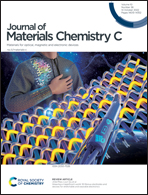Biaxial strain induced multiple magnetic phase transitions in nonmagnetic transition metal halide monolayer
Abstract
Two-dimensional (2D) materials are sensitive to external stimuli. In this work, via a combined first-principles simulations and constrained random phase approximation, we report strain-induced multiple magnetic phase transitions in an exfoliable nonmagnetic metallic 2D material ScI2. Interestingly, monolayer ScI2 has a high density of states at the Fermi level [N(EF)]. Its product with the Stoner parameter is estimated to be slightly below the critical value of the Stoner criterion for spontaneous spin splitting. Moreover, we show bi-axial strains can effectively increase the N(EF) of ScI2, leading to phase transitions to magnetic states. While the tensile strain first yields an antiferromagnetic state at the critical magnitude of 3%, then a normal ferromagnetic state at 5%, and half-metallicity with large spin flip gaps for the minority spins for strains ≥ 6%, compressive strain induces a ferromagnetic configuration ranging from −6% to −10%. Our results demonstrate a system with strain controllable magnetic states, appealing for straintronic and spintronic applications, and provide guidance on the design of extrinsic 2D magnetic materials.



 Please wait while we load your content...
Please wait while we load your content...